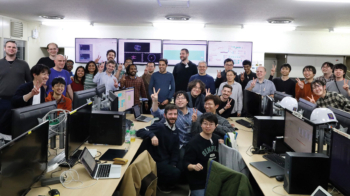
An international team has made an advance towards more compact particle accelerators, demonstrating that beams can be focused via a technique called active plasma lensing without reducing the beam quality.
Building smaller particle accelerators has been a goal of the particle accelerator community for decades, both for basic research and applications such as radiotherapy. In addition to new accelerating mechanisms, smaller accelerators require novel ways to focus particle beams.
Active plasma lensing uses a large electric current to set up strong magnetic fields in a plasma that can focus high-energy beams over distances of centimetres, rather than metres as is the case for conventional magnet-based techniques. However, the large current also heats the plasma, preferentially heating the centre of the lens. This temperature gradient leads to a nonlinear magnetic field, an aberration, which degrades the particle-beam quality.
Using a high-quality 200 MeV electron beam at the CLEAR user facility at CERN, Carl A Lindstrøm of the University of Oslo, Norway, and collaborators recently made the first direct measurement of this aberration in an active plasma lens, finding it to be consistent with theory. More importantly, they discovered that this aberration can be suppressed by simply changing the gas used to make the plasma from a light gas (helium) to a heavier gas (argon). Changing the gas slows down the heat transfer so that the aberration does not have time to form, resulting in ideal, degradation-free focusing. It represents a significant step towards making active plasma lenses a standard accelerator component in the future, says the team.
CLEAR evolved from a test facility for the Compact Linear Collider (CLIC) called CTF3, which ended a successful programme in 2016. CLEAR offers general accelerator R&D and component studies for existing and possible future accelerator applications, such as high-gradient “X-band” acceleration methods (CERN Courier April 2018 p32), as well as prototyping and validation of accelerator components for the High-Luminosity LHC upgrade.
“Working at CLEAR was very efficient and fast-paced – not always the case in large-scale accelerator facilities,” says Lindstrøm. “Naturally, we hope to continue our plasma lens research at CLEAR. One exciting direction is probing the limits of how strong these lenses can be. This is clearly the lens of the future.”
Further reading
C A Lindstrøm et al. 2018 Phys. Rev. Lett. 121 194801.





